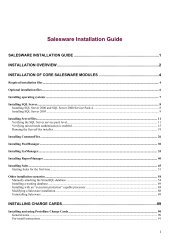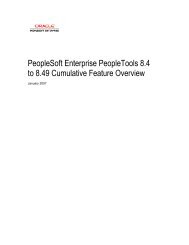Cognos ReportNetTM Installation and Configuration Guide
Cognos ReportNetTM Installation and Configuration Guide
Cognos ReportNetTM Installation and Configuration Guide
You also want an ePaper? Increase the reach of your titles
YUMPU automatically turns print PDFs into web optimized ePapers that Google loves.
Chapter 4: Configuring ReportNet<br />
When you change the port used by the local dispatcher, you must change the value of the<br />
Internal dispatcher URI property. Because the change affects all the URIs that are based on the<br />
local dispatcher, you must change the URIs of all local components. By default, local<br />
components contain localhost in the URI.<br />
For example, if you install all components on one computer <strong>and</strong> you change the dispatcher port,<br />
you must also change the port in the local Content Manager URI <strong>and</strong> local SDK URI.<br />
If you change the dispatcher port in the local Dispatcher URI, ensure that you specify the new<br />
port numbers when you configure remote computers that use the Dispatcher URI, Content<br />
Manager URI, <strong>and</strong> SDK URI properties.<br />
Steps<br />
1. Start <strong>Cognos</strong> <strong>Configuration</strong>.<br />
2. In the Explorer window click the appropriate group or component:<br />
• To change the port number for the dispatcher, click Environment.<br />
• To change the port number for the local log server, under Environment, click Logging.<br />
3. In the Properties window, click the Value box next to the property that you want to change.<br />
4. If you change the dispatcher port, ensure that you change the ports in other URIs that<br />
contain localhost.<br />
5. From the File menu, click Save.<br />
Using an Authentication Provider<br />
ReportNet runs with or without authentication providers. By default, anonymous access is<br />
enabled.<br />
You can configure multiple namespaces for authentication <strong>and</strong> then choose at run time which<br />
namespace you want to use. For more information, see the Administration <strong>and</strong> Security <strong>Guide</strong>.<br />
If you enable security, you must configure security settings immediately after you complete the<br />
installation <strong>and</strong> configuration process. For more information, see the Administration <strong>and</strong><br />
Security <strong>Guide</strong>.<br />
Important: We recommend that you do not disable security after you enable it. If you previously<br />
configured a namespace that is no longer in the current configuration, when you start<br />
ReportNet, the namespace, including the user accounts, are permanently deleted from the<br />
content store. Restoring the namespace definition, by using a previously saved crnstartup.xml<br />
file for example, does not restore the user accounts. This means that for the users defined in the<br />
deleted namespace, their preferences, My Folders <strong>and</strong> My Pages entries are permanently lost.<br />
Existing policies will continue to refer to users, groups or roles that no longer exist. While this will<br />
not affect how the policies work, a user administering the policy may see "unknown" entries.<br />
Because these entries refer to users, groups, <strong>and</strong> roles which no longer exist, you can safely<br />
delete them.<br />
To use an authentication provider <strong>and</strong> to require users to authenticate:<br />
❑ Disable anonymous access.<br />
❑ Configure ReportNet to use an authentication provider.<br />
Disable Anonymous Access<br />
By default, ReportNet does not require user authentication. Users can logon anonymously.<br />
You can use <strong>Cognos</strong> <strong>Configuration</strong> to disable anonymous access.<br />
Steps<br />
1. On the computer where you installed Content Manager, start <strong>Cognos</strong> <strong>Configuration</strong>.<br />
2. In the Explorer window, under Security, Authentication, click <strong>Cognos</strong>.<br />
The <strong>Cognos</strong> resource represents the <strong>Cognos</strong> namespace. The <strong>Cognos</strong> namespace stores<br />
information about <strong>Cognos</strong> groups, such as the Anonymous User, contacts, <strong>and</strong> distribution<br />
lists, <strong>and</strong> refers to objects in other security namespaces. For more information, see the<br />
Administration <strong>and</strong> Security <strong>Guide</strong>.<br />
<strong>Installation</strong> <strong>and</strong> <strong>Configuration</strong> <strong>Guide</strong> 41
















